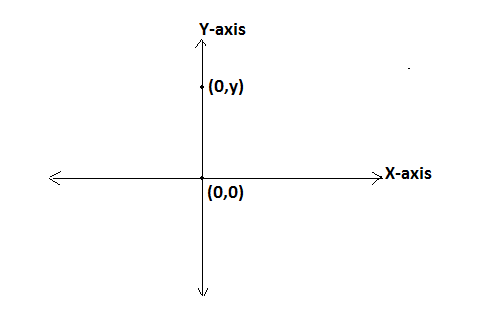
What is the abscissa of any point on y-axis?
Answer
510k+ views
Hint: In this question, we use the concept of graph and coordinates. We know the representation of coordinates on a graph is like (x, y) where x represents abscissa and y represents ordinate.
Complete Step-by-Step solution:
Now, we assume a coordinate A (x, y) where x represents abscissa and y represents ordinate.
If point A (x, y) moves left and right on a graph so the abscissa of coordinate A becomes changed. For example, a coordinate (2, 3) moves right through 1 unit distance so the coordinates become (3, 3). If a coordinate (2, 3) moves left through 1 unit distance so the coordinates become (1, 3).
If point A (x, y) moves upward and downward on a graph then the ordinate of coordinate A becomes changed. For example, a coordinate (2, 3) moves upward through 1 unit distance so the coordinates become (2, 4). If a coordinate (2, 3) moves downward through 1 unit distance so the coordinates become (2, 2).
Now, if a point on y-axis is the representation of coordinates on y-axis like (0, y) and then if we move point right and left on a graph so the abscissa of coordinates does not change it's always zero (0). But if we move point upward and downward so the ordinate of coordinates becomes changed.
So, the abscissa of any point on the y-axis is always zeros (0).
Note: In such types of problems we have to assume a point on graph and try to move point on graph in all four directions then observe the changes in point while moving in specific direction. In case of any point on y axis so the abscissa of such types of coordinates is always zero (0).

Complete Step-by-Step solution:
Now, we assume a coordinate A (x, y) where x represents abscissa and y represents ordinate.
If point A (x, y) moves left and right on a graph so the abscissa of coordinate A becomes changed. For example, a coordinate (2, 3) moves right through 1 unit distance so the coordinates become (3, 3). If a coordinate (2, 3) moves left through 1 unit distance so the coordinates become (1, 3).
If point A (x, y) moves upward and downward on a graph then the ordinate of coordinate A becomes changed. For example, a coordinate (2, 3) moves upward through 1 unit distance so the coordinates become (2, 4). If a coordinate (2, 3) moves downward through 1 unit distance so the coordinates become (2, 2).
Now, if a point on y-axis is the representation of coordinates on y-axis like (0, y) and then if we move point right and left on a graph so the abscissa of coordinates does not change it's always zero (0). But if we move point upward and downward so the ordinate of coordinates becomes changed.
So, the abscissa of any point on the y-axis is always zeros (0).
Note: In such types of problems we have to assume a point on graph and try to move point on graph in all four directions then observe the changes in point while moving in specific direction. In case of any point on y axis so the abscissa of such types of coordinates is always zero (0).

Recently Updated Pages
What is the degree of the angle at 6 oclock-class-8-maths-CBSE

Bad effects of various festivals on the environment class 8 chemistry CBSE

How would you describe a globe class 8 physics CBSE

Whats the square root of 3721 class 8 maths CBSE

A container has a capacity of 300 litres If the liquid class 8 maths CBSE

A colour TV is available for Rs 13440 inclusive of class 8 maths CBSE

Trending doubts
For Frost what do fire and ice stand for Here are some class 10 english CBSE

What did the military generals do How did their attitude class 10 english CBSE

What did being free mean to Mandela as a boy and as class 10 english CBSE

What did Valli find about the bus journey How did she class 10 english CBSE

Can you say how 10th May is an Autumn day in South class 10 english CBSE

Explain the Treaty of Vienna of 1815 class 10 social science CBSE




